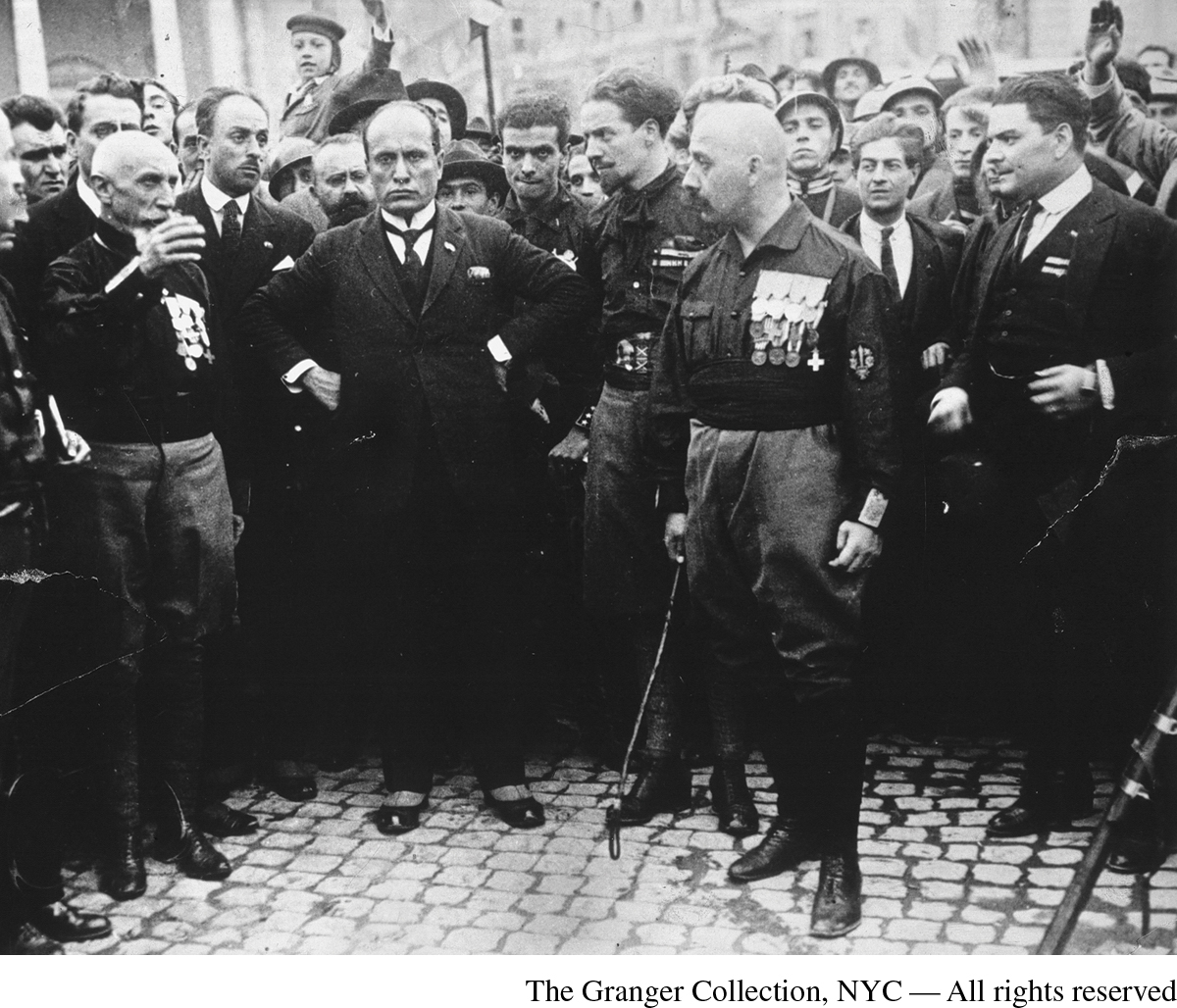Fascism on the March in Italy
Printed Page 852
Important EventsFascism on the March in Italy
In Italy, the rise to power of political journalist Benito Mussolini (1883–1945), who had turned from socialism to the radical right, kept the war alive. Italians raged when the Allies at Paris refused to honor the territorial promises of the Treaty of London, and peasants and workers protested their economic plight during the slump of the early 1920s. Many Europeans blamed parliaments and constitutions for their troubles, so Italians backed Mussolini when he gathered veterans and unemployed men into a personal army (the Black Shirts) to overturn parliamentary government. In 1922, his supporters, known as the Fascists, started a march on Rome, forcing King Victor Emmanuel III (r. 1900–1946) to make Mussolini prime minister.

Like the Bolsheviks, Mussolini promised an efficient military utopia and the restoration of men’s warrior status. The Black Shirts attracted many young men who felt cheated of wartime glory and many veterans who missed the vigor of military life. The fasces, an ancient Roman symbol depicting a bundle of sticks wrapped around an ax with the blade exposed (representing both unity and force), served as the movement’s emblem and provided its name: fascism. Unlike Marxism, fascism scoffed at coherent ideology: “Fascism is not a church,” Mussolini announced. “It is more like a training ground.” The Fascist Party was defined by deeds—specifically its promotion of male violence and its attacks on parliamentary rule.
Mussolini criminalized any criticism of the state and used violence against opponents in parliament. Bands of men from the Fascist Party attacked striking workers, using their favorite tactic of forcing castor oil (which caused diarrhea) down the throats of socialists, and even murdering rivals. Yet the sight of the Black Shirts marching through the streets like disciplined soldiers signaled to many Italians that their country was orderly and modern. Large landowners and businessmen approved the Fascists’ attacks on strikers and therefore financed the movement. Their generous funding allowed Mussolini to build a large staff by hiring the unemployed, creating the illusion that the Fascists could rescue the economy when no one else could.
Like a wartime leader, Mussolini used mass propaganda to build support for a kind of military campaign to remake Italy. Peasant men huddled around radios to hear him call for a “battle of wheat” to enhance farm productivity. Peasant women adored him for appearing to value motherhood. In the cities the government launched avant-garde architectural projects and used public relations promoters to advertise its achievements. The modern city became a stage set for Fascist spectacles captured by newsreel cameras and broadcast by radio. Mussolini claimed that he made the trains run on time, and this triumph of modern technology fanned people’s hopes that he could restore order, albeit violently.
Mussolini added traditional values and prejudices to his modern order. An atheist himself, he recognized the importance of Catholicism in Italian life. In 1929, the Lateran Agreement between the Italian government and the church made the Vatican an independent state under papal sovereignty. The government recognized the church’s right to determine marriage and family policy; in return, the church ended its criticism of Fascist tactics. Mussolini also outlawed labor unions, replacing them with organized groups of employers, workers, and professionals to settle grievances and determine conditions of work. Mussolini drew praise from business leaders and professionals when he announced cuts in women’s wages and a ban on women in the professions. Mussolini aimed to confine women to low-paying jobs as part of his scheme for reinvigorating men.
REVIEW QUESTION How did the postwar atmosphere influence cultural life and encourage the trend toward dictatorship?
Mussolini’s numerous admirers across the West included Adolf Hitler, who throughout the 1920s had been building a paramilitary group of storm troopers alongside a political organization called the National Socialist German Workers’ Party (the Nazi Party). During his brief stint in jail for the 1923 Beer Hall Putsch, Hitler wrote Mein Kampf (My Struggle); in the book, he expressed both his vicious anti-Semitism and his recipe for manipulating the masses. Hitler was fascinated by Mussolini’s legal accession to power and his triumph over all opposition. Late in the 1920s, however, the conditions that had allowed Mussolini to rise to power in 1922 no longer existed in Germany. Although the Nazi Party was becoming a strong political instrument, Weimar democracy was functioning better as the decade wore on.